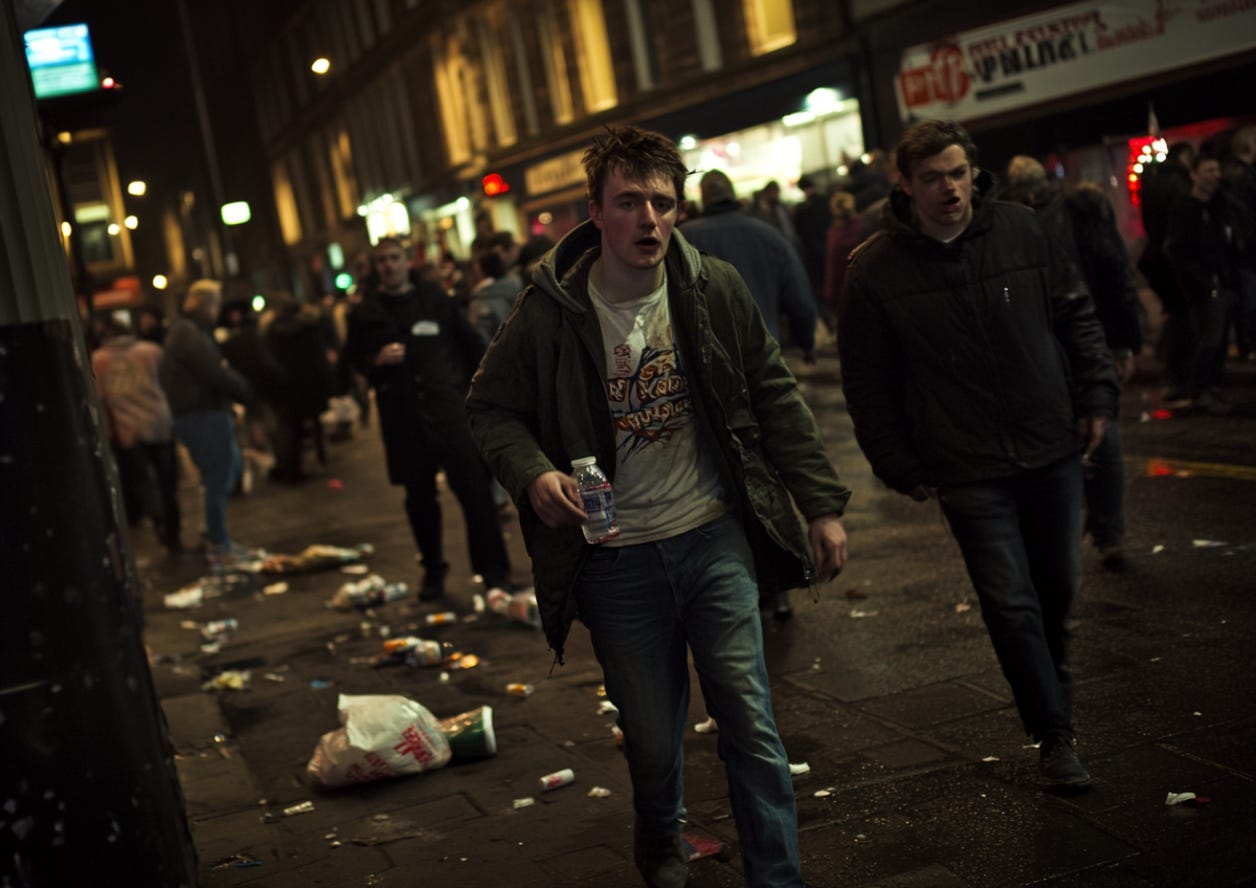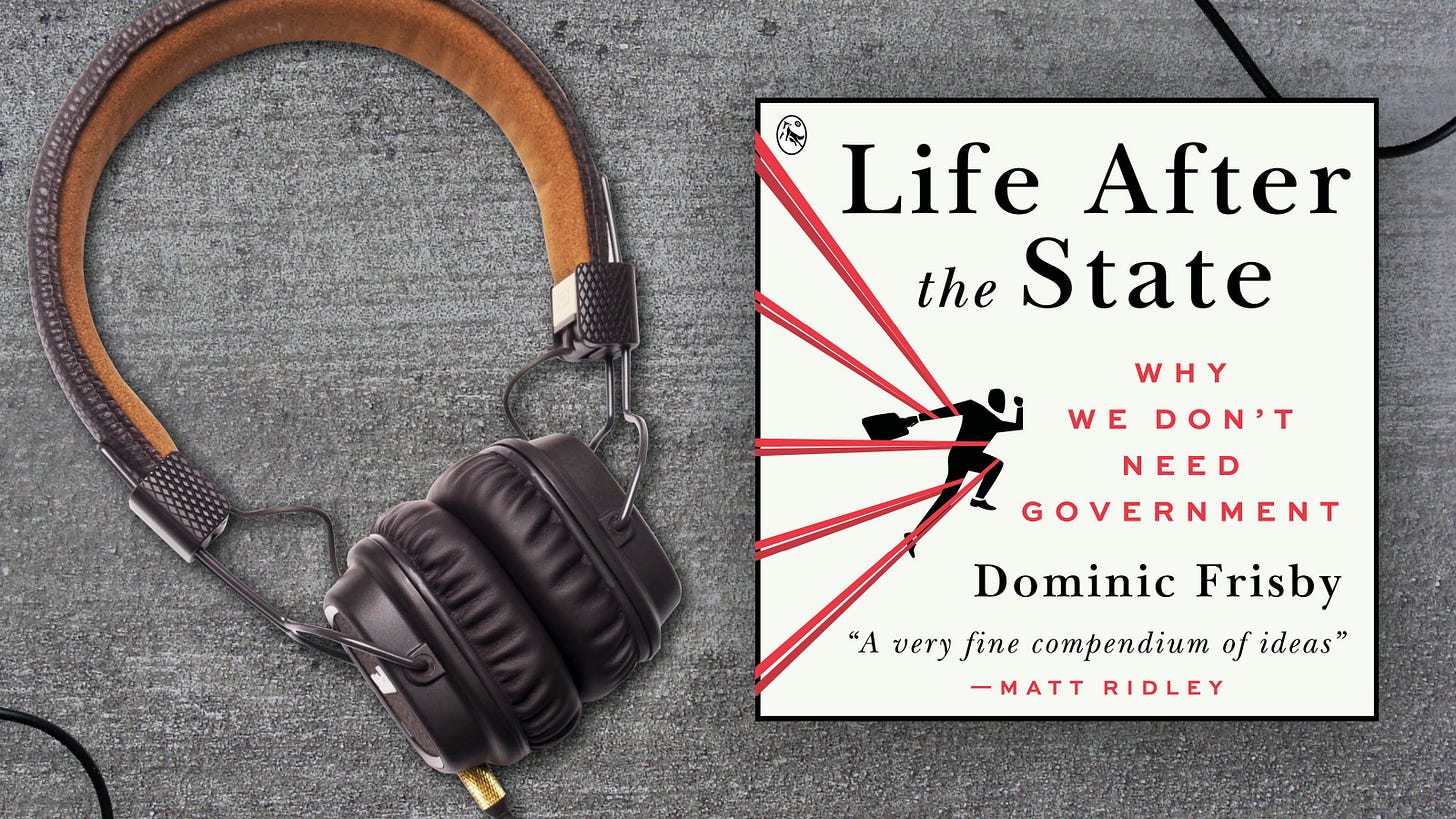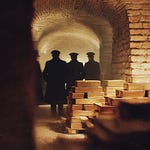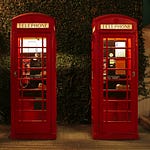Good Sunday morning to you,
I am just on a train home from Glasgow, where I have been gigging these past two nights. I’ve had a great time, as I always seem to do when I go north of the wall.
But Glasgow on a Saturday night is something else. My hotel was right next to the station and so I was right in the thick of it. If I ever get to make a cacatopian, end-of-days, post-apocalyptic thriller, I’ll just stroll through Glasgow city centre on a Friday or Saturday night with a camera to get all the B roll. It was like walking through a Hieronymus Bosch painting only with a Scottish accent.
Little seems to have changed since I wrote that infamous chapter about Glasgow in Life After the State all those years ago. The only difference is that now it’s more multi-ethnic. So many people are so off their heads. I lost count of the number of randoms wandering about just howling at the stars. The long days - it was still light at 10 o’clock - make the insanity all the more visible. Part of me finds it funny, but another part of me finds it so very sad that so many people let themselves get into this condition.
It prompted me to revisit said chapter, and I offer it today as your Sunday thought piece.
Just a couple of little notes, before we begin. This caught my eye on Friday. Our favourite uranium tech company, Lightbridge Fuels (NASDAQ:LTBR), has taken off again with Donald Trump’s statement that he is going to quadruple US nuclear capacity. The stock was up 45% in a day. We first looked at it in October at $3. It hit $15 on Friday.
It’s one to sell on the spikes and buy on the dips, as this incredible chart shows.
(In other news I have now listened twice to the Comstock Lode AGM, and I’ll report back on that shortly too).
ICYMI here is my mid-week commentary, which attracted a lot of attention
Right - Glasgow.
(NB I haven’t included references here. Needless to say, they are all there in the book. And sorry I don’t have access to the audio of me reading this from my laptop, but, if you like, you can get the audiobook at Audible, Apple Books and all good audiobookshops. The book itself available at Amazon, Apple Books et al).
How the Most Entrepreneurial City in Europe Became Its Sickest
The cause of waves of unemployment is not capitalism, but governments …
Friedrich Hayek, economist and philosopher
In the 18th and 19th centuries, the city of Glasgow in Scotland became enormously, stupendously rich. It happened quite organically, without planning. An entrepreneurial people reacted to their circumstances and, over time, turned Glasgow into an industrial and economic centre of such might that, by the turn of the 20th century, Glasgow was producing half the tonnage of Britain’s ships and a quarter of all locomotives in the world. (Not unlike China’s industrial dominance today). It was regarded as the best-governed city in Europe and popular histories compared it to the great imperial cities of Venice and Rome. It became known as the ‘Second City of the British Empire’.
Barely 100 years later, it is the heroin capital of the UK, the murder capital of the UK and its East End, once home to Europe’s largest steelworks, has been dubbed ‘the benefits capital of the UK’. Glasgow is Britain’s fattest city: its men have Britain’s lowest life expectancy – on a par with Palestine and Albania – and its unemployment rate is 50% higher than the rest of the UK.
How did Glasgow manage all that?
The growth in Glasgow’s economic fortunes began in the latter part of the 17th century and the early 18th century. First, the city’s location in the west of Scotland at the mouth of the river Clyde meant that it lay in the path of the trade winds and at least 100 nautical miles closer to America’s east coast than other British ports – 200 miles closer than London. In the days before fossil fuels (which only found widespread use in shipping in the second half of the 19th century) the journey to Virginia was some two weeks shorter than the same journey from London or many of the other ports in Britain and Europe. Even modern sailors describe how easy the port of Glasgow is to navigate. Second, when England was at war with France – as it was repeatedly between 1688 and 1815 – ships travelling to Glasgow were less vulnerable than those travelling to ports further south. Glasgow’s merchants took advantage and, by the early 18th century, the city had begun to assert itself as a trading hub. Manufactured goods were carried from Britain and Europe to North America and the Caribbean, where they were traded for increasingly popular commodities such as tobacco, cotton and sugar.
Through the 18th century, the Glasgow merchants’ business networks spread, and they took steps to further accelerate trade. New ships were introduced, bigger than those of rival ports, with fore and aft sails that enabled them to sail closer to the wind and reduce journey times. Trading posts were built to ensure that cargo was gathered and stored for collection, so that ships wouldn’t swing idly at anchor. By the 1760s Glasgow had a 50% share of the tobacco trade – as much as the rest of Britain’s ports combined. While the English merchants simply sold American tobacco in Europe at a profit, the Glaswegians actually extended credit to American farmers against future production (a bit like a crop future today, where a crop to be grown at a later date is sold now). The Virginia farmers could then use this credit to buy European goods, which the Glaswegians were only too happy to supply. This brought about the rise of financial institutions such as the Glasgow Ship Bank and the Glasgow Thistle Bank, which would later become part of the now-bailed-out, taxpayer-owned Royal Bank of Scotland (RBS).
Their practices paid rewards. Glasgow’s merchants earned a great deal of money. They built glamorous homes and large churches and, it seems, took on aristocratic airs – hence they became known as the ‘Tobacco Lords’. Numbering among them were Buchanan, Dunlop, Ingram, Wilson, Oswald, Cochrane and Glassford, all of whom had streets in the Merchant City district of Glasgow named after them (other streets, such as Virginia Street and Jamaica Street, refer to their trade destinations). In 1771, over 47 million pounds of tobacco were imported.
However, the credit the Glaswegians extended to American tobacco farmers would backfire. The debts incurred by the tobacco farmers – which included future presidents George Washington and Thomas Jefferson (who almost lost his farm as a result) – grew, and were among the grievances when the American War of Independence came in 1775. That war destroyed the tobacco trade for the Glaswegians. Much of the money that was owed to them was never repaid. Many of their plantations were lost. But the Glaswegians were entrepreneurial and they adapted. They moved on to other businesses, particularly cotton.
By the 19th century, all sorts of local industry had emerged around the goods traded in the city. It was producing and exporting textiles, chemicals, engineered goods and steel. River engineering projects to dredge and deepen the Clyde (with a view to forming a deep- water port) had begun in 1768 and they would enable shipbuilding to become a major industry on the upper reaches of the river, pioneered by industrialists such as Robert Napier and John Elder. The final stretch of the Monkland Canal, linking the Forth and Clyde Canal at Port Dundas, was opened in 1795, facilitating access to the iron-ore and coal mines of Lanarkshire.
The move to fossil-fuelled shipping in the latter 19th century destroyed the advantages that the trade winds had given Glasgow. But it didn’t matter. Again, the people adapted. By the turn of the 20th century the Second City of the British Empire had become a world centre of industry and heavy engineering. It has been estimated that, between 1870 and 1914, it produced as much as one-fifth of the world’s ships, and half of Britain’s tonnage. Among the 25,000 ships it produced were some of the greatest ever built: the Cutty Sark, the Queen Mary, HMS Hood, the Lusitania, the Glenlee tall ship and even the iconic Mississippi paddle steamer, the Delta Queen. It had also become a centre for locomotive manufacture and, shortly after the turn of the 20th century, could boast the largest concentration of locomotive building works in Europe.
It was not just Glasgow’s industry and wealth that was so gargantuan. The city’s contribution to mankind – made possible by the innovation and progress that comes with booming economies – would also have an international impact. Many great inventors either hailed from Glasgow or moved there to study or work. There’s James Watt, for example, whose improvements to the steam engine were fundamental to the Industrial Revolution. One of Watt’s employees, William Murdoch, has been dubbed ‘the Scot who lit the world’ – he invented gas lighting, a new kind of steam cannon and waterproof paint. Charles MacIntosh gave us the raincoat. James Young, the chemist dubbed as ‘the father of the oil industry’, gave us paraffin. William Thomson, known as Lord Kelvin, developed the science of thermodynamics, formulating the Kelvin scale of absolute temperature; he also managed the laying of the first transatlantic telegraph cable.
The turning point in the economic fortunes of Glasgow – indeed, of industrial Britain – was WWI. Both have been in decline ever since. By the end of the war, the British were drained, both emotionally and in terms of capital and manpower; the workers, the entrepreneurs, the ideas men, too many of them were dead or incapacitated. There was insufficient money and no appetite to invest. The post-war recession, and later the Great Depression, did little to help. The trend of the city was now one of inexorable economic decline.
If Glasgow was the home of shipping and industry in 19th-century Britain, it became the home of socialism in the 20th century. Known by some as the ‘Red Clydeside’ movement, the socialist tide in Scotland actually pre-dated the First World War. In 1906 came the city’s first Labour Member of Parliament (MP), George Barnes – prior to that its seven MPs were all Conservatives or Liberal Unionists. In the spring of 1911, 11,000 workers at the Singer sewing-machine factory (run by an American corporation in Clydebank) went on strike to support 12 women who were protesting about new work practices. Singer sacked 400 workers, but the movement was growing – as was labour unrest. In the four years between 1910 and 1914 Clydebank workers spent four times as many days on strike than in the whole of the previous decade. The Scottish Trades Union Congress and its affiliations saw membership rise from 129,000 in 1909 to 230,000 in 1914.20
The rise in discontent had much to do with Glasgow’s housing. Conditions were bad, there was overcrowding, bad sanitation, housing was close to dirty, noxious and deafening industry. Unions grew quite organically to protect the interests of their members.
Then came WWI, and inflation, as Britain all but abandoned gold. In 1915 many landlords responded by attempting to increase rent, but with their young men on the Western front, those left behind didn’t have the means to pay these higher costs. If they couldn’t, eviction soon followed. In Govan, an area of Glasgow where shipbuilding was the main occupation, women – now in the majority with so many men gone – organized opposition to the rent increases. There are photographs showing women blocking the entrance to tenements; officers who did get inside to evict tenants are said to have had their trousers pulled down.
The landlords were attacked for being unpatriotic. Placards read: ‘While our men are fighting on the front line,the landlord is attacking us at home.’ The strikes spread to other cities throughout the UK, and on 27 November 1915 the government introduced legislation to restrict rents to the pre-war level. The strikers were placated. They had won. The government was happy; it had dealt with the problem. The landlords lost out.
In the aftermath of the Russian Revolution of 1917, more frequent strikes crippled the city. In 1919 the ‘Bloody Friday’ uprising prompted the prime minister, David Lloyd George, to deploy 10,000 troops and tanks onto the city’s streets. By the 1930s Glasgow had become the main base of the Independent Labour Party, so when Labour finally came to power alone after WWII, its influence was strong. Glasgow has always remained a socialist stronghold. Labour dominates the city council, and the city has not had a Conservative MP for 30 years.
By the late 1950s, Glasgow was losing out to the more competitive industries of Japan, Germany and elsewhere. There was a lack of investment. Union demands for workers, enforced by government legislation, made costs uneconomic and entrepreneurial activity arduous. With lack of investment came lack of innovation.
Rapid de-industrialization followed, and by the 1960s and 70s most employment lay not in manufacturing, but in the service industries.
Which brings us to today. On the plus side, Glasgow is still ranked as one of Europe’s top 20 financial centres and is home to some leading Scottish businesses. But there is considerable downside.
Recent studies have suggested that nearly 30% of Glasgow’s working age population is unemployed. That’s 50% higher than that of the rest of Scotland or the UK. Eighteen per cent of 16- to 19-year-olds are neither in school nor employed. More than one in five working-age Glaswegians have no sort of education that might qualify them for a job.
In the city centre, the Merchant City, 50% of children are growing up in homes where nobody works. In the poorer neighbourhoods, such as Ruchill, Possilpark, or Dalmarnock, about 65% of children live in homes where nobody works – more than three times the national average. Figures from the Department of Work and Pensions show that 85% of working age adults from the district of Bridgeton claim some kind of welfare payment.
Across the city, almost a third of the population regularly receives sickness or incapacity benefit, the highest rate of all UK cities. A 2008 World Health Organization report noted that in Glasgow’s Calton, Bridgeton and Queenslie neighbourhoods, the average life expectancy for males is only 54. In contrast, residents of Glasgow’s more affluent West End live to be 80 and virtually none of them are on the dole.
Glasgow has the highest crime rate in Scotland. A recent report by the Centre for Social Justice noted that there are 170 teenage gangs in Glasgow. That’s the same number as in London, which has over six times the population of Glasgow.
It also has the dubious record of being Britain’s murder capital. In fact, Glasgow had the highest homicide rate in Western Europe until it was overtaken in 2012 by Amsterdam, with more violent crime per head of population than even New York. What’s more, its suicide rate is the highest in the UK.
Then there are the drug and alcohol problems. The residents of the poorer neighbourhoods are an astounding six times more likely to die of a drugs overdose than the national average. Drug-related mortality has increased by 95% since 1997. There are 20,000 registered drug users – that’s just registered – and the situation is not going to get any better: children who grow up in households where family members use drugs are seven times more likely to end up using drugs themselves than children who live in drug-free families.
Glasgow has the highest incidence of liver diseases from alcohol abuse in all of Scotland. In the East End district of Dennistoun, these illnesses kill more people than heart attacks and lung cancer combined. Men and women are more likely to die of alcohol-related deaths in Glasgow than anywhere else in the UK. Time and time again Glasgow is proud winner of the title ‘Fattest City in Britain’. Around 40% of the population are obese – 5% morbidly so – and it also boasts the most smokers per capita.
I have taken these statistics from an array of different sources. It might be in some cases that they’re overstated. I know that I’ve accentuated both the 18th- and 19th-century positives, as well as the 20th- and 21st-century negatives to make my point. Of course, there are lots of healthy, happy people in Glasgow – I’ve done many gigs there and I loved it. Despite the stories you hear about intimidating Glasgow audiences, the ones I encountered were as good as any I’ve ever performed in front of. But none of this changes the broad-brush strokes: Glasgow was a once mighty city that now has grave social problems. It is a city that is not fulfilling its potential in the way that it once did. All in all, it’s quite a transformation. How has it happened?
Every few years a report comes out that highlights Glasgow’s various problems. Comments are then sought from across the political spectrum. Usually, those asked to comment agree that the city has grave, ‘long-standing and deep-rooted social problems’ (the words of Stephen Purcell, former leader of Glasgow City Council); they agree that something needs to be done, though they don’t always agree on what that something is.
There’s the view from the right: Bill Aitken of the Scottish Conservatives, quoted in The Sunday Times in 2008, said, ‘We simply don’t have the jobs for people who are not academically inclined. Another factor is that some people are simply disinclined to work. We have got to find something for these people to do, to give them a reason to get up in the morning and give them some self-respect.’ There’s the supposedly apolitical view of anti-poverty groups: Peter Kelly, director of the Glasgow-based Poverty Alliance, responded, ‘We need real, intensive support for people if we are going to tackle poverty. It’s not about a lack of aspiration, often people who are unemployed or on low incomes are stymied by a lack of money and support from local and central government.’ And there’s the view from the left. In the same article, Patricia Ferguson, the Labour Member of the Scottish Parliament (MSP) for Maryhill, also declared a belief in government regeneration of the area. ‘It’s about better housing, more jobs, better education and these things take years to make an impact. I believe that the huge regeneration in the area is fostering a lot more community involvement and cohesion. My real hope is that these figures will take a knock in the next five or ten years.’ At the time of writing in 2013, five years later, the figures have worsened.
All three points of view agree on one thing: the government must do something.
In 2008 the £435 million Fairer Scotland Fund – established to tackle poverty – was unveiled, aiming to allocate cash to the country’s most deprived communities. Its targets included increasing average income among lower wage-earners and narrowing the poverty gap between Scotland’s best- and worst-performing regions by 2017. So far, it hasn’t met those targets.
In 2008 a report entitled ‘Power for The Public’ examined the provision of health, education and justice in Scotland. It said the budgets for these three areas had grown by 55%, 87% and 44% respectively over the last decade, but added that this had produced ‘mixed results’. ‘Mixed results’ means it didn’t work. More money was spent and the figures got worse.
After the Centre for Social Justice report on Glasgow in 2008, Iain Duncan Smith (who set up this think tank, and is now the Secretary of State for Work and Pensions) said, ‘Policy must deal with the pathways to breakdown – high levels of family breakdown, high levels of failed education, debt and unemployment.’
So what are ‘pathways to breakdown’? If you were to look at a chart of Glasgow’s prosperity relative to the rest of the world, its peak would have come somewhere around 1910. With the onset of WWI in 1914 its decline accelerated, and since then the falls have been relentless and inexorable. It’s not just Glasgow that would have this chart pattern, but the whole of industrial Britain. What changed the trend? Yes, empires rise and fall, but was British decline all a consequence of WWI? Or was there something else?
A seismic shift came with that war – a change which is very rarely spoken or written about. Actually, the change was gradual and it pre-dated 1914. It was a change that was sweeping through the West: that of government or state involvement in our lives. In the UK it began with the reforms of the Liberal government of 1906–14, championed by David Lloyd George and Winston Churchill, known as the ‘terrible twins’ by contemporaries. The Pensions Act of 1908, the People’s Budget of 1909–10 (to ‘wage implacable warfare against poverty’, declared Lloyd George) and the National Insurance Act of 1911 saw the Liberal government moving away from its tradition of laissez-faire systems – from classical liberalism and Gladstonian principles of self-help and self-reliance – towards larger, more active government by which taxes were collected from the wealthy and the proceeds redistributed. Afraid of losing votes to the emerging Labour party and the increasingly popular ideology of socialism, modern liberals betrayed their classical principles. In his War Memoirs, Lloyd George said ‘the partisan warfare that raged around these topics was so fierce that by 1913, this country was brought to the verge of civil war’. But these were small steps. The Pensions Act, for example, meant that men aged 70 and above could claim between two and five shillings per week from the government. But average male life- expectancy then was 47. Today it’s 77. Using the same ratio, and, yes, I’m manipulating statistics here, that’s akin to only awarding pensions to people above the age 117 today. Back then it was workable.
To go back to my analogy of the prologue, this period was when the ‘train’ was set in motion across the West. In 1914 it went up a gear. Here are the opening paragraphs of historian A. J. P. Taylor’s most celebrated book, English History 1914–1945, published in 1965.
I quote this long passage in full, because it is so telling.
Until August 1914 a sensible, law-abiding Englishman could pass through life and hardly notice the existence of the state, beyond the post office and the policeman. He could live where he liked and as he liked. He had no official number or identity card. He could travel abroad or leave his country forever without a passport or any sort of official permission. He could exchange his money for any other currency without restriction or limit. He could buy goods from any country in the world on the same terms as he bought goods at home. For that matter, a foreigner could spend his life in this country without permit and without informing the police. Unlike the countries of the European continent, the state did not require its citizens to perform military service. An Englishman could enlist, if he chose, in the regular army, the navy, or the territorials. He could also ignore, if he chose, the demands of national defence. Substantial householders were occasionally called on for jury service. Otherwise, only those helped the state, who wished to do so. The Englishman paid taxes on a modest scale: nearly £200 million in 1913–14, or rather less than 8% of the national income.The state intervened to prevent the citizen from eating adulterated food or contracting certain infectious diseases. It imposed safety rules in factories, and prevented women, and adult males in some industries,from working excessive hours.The state saw to it that children received education up to the age of 13. Since 1 January 1909, it provided a meagre pension for the needy over the age of 70. Since 1911, it helped to insure certain classes of workers against sickness and unemployment. This tendency towards more state action was increasing. Expenditure on the social services had roughly doubled since the Liberals took office in 1905. Still, broadly speaking, the state acted only to help those who could not help themselves. It left the adult citizen alone.
All this was changed by the impact of the Great War. The mass of the people became, for the first time, active citizens. Their lives were shaped by orders from above; they were required to serve the state instead of pursuing exclusively their own affairs. Five million men entered the armed forces, many of them (though a minority) under compulsion. The Englishman’s food was limited, and its quality changed, by government order. His freedom of movement was restricted; his conditions of work prescribed. Some industries were reduced or closed, others artificially fostered. The publication of news was fettered. Street lights were dimmed. The sacred freedom of drinking was tampered with: licensed hours were cut down, and the beer watered by order. The very time on the clocks was changed. From 1916 onwards, every Englishman got up an hour earlier in summer than he would otherwise have done, thanks to an act of parliament. The state established a hold over its citizens which, though relaxed in peacetime, was never to be removed and which the Second World war was again to increase. The history of the English state and of the English people merged for the first time.
Since the beginning of WWI , the role that the state has played in our lives has not stopped growing. This has been especially so in the case of Glasgow. The state has spent more and more, provided more and more services, more subsidy, more education, more health care, more infrastructure, more accommodation, more benefits, more regulations, more laws, more protection. The more it has provided, the worse Glasgow has fared. Is this correlation a coincidence? I don’t think so.
The story of the rise and fall of Glasgow is a distilled version of the story of the rise and fall of industrial Britain – indeed the entire industrial West. In the next chapter I’m going to show you a simple mistake that goes on being made; a dynamic by which the state, whose very aim was to help Glasgow, has actually been its ‘pathway to breakdown’ . . .
Life After the State is available at Amazon, Apple Books and all good bookshops, with the audiobook at Audible, Apple Books and all good audiobookshops.
















